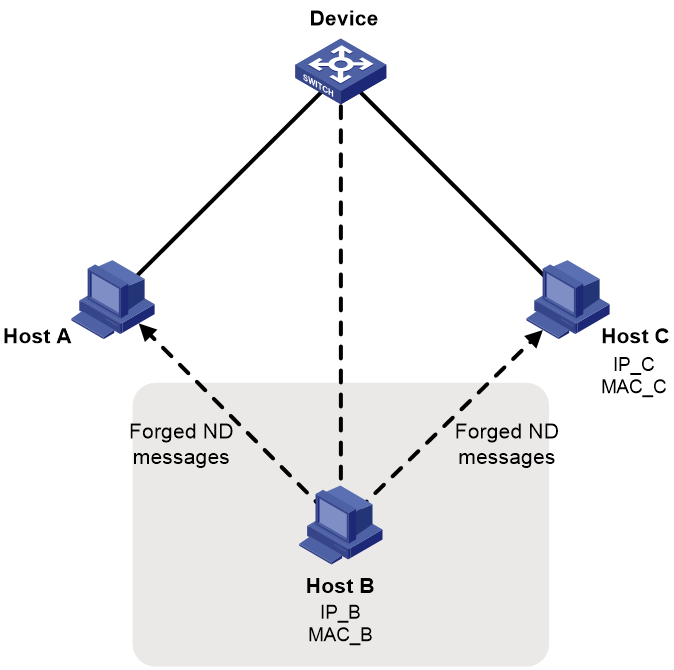- Table of Contents
-
- 18-Security Configuration Guide
- 00-Preface
- 01-Keychain configuration
- 02-Public key management
- 03-PKI configuration
- 04-Crypto engine configuration
- 05-SSH configuration
- 06-SSL configuration
- 07-Packet filter configuration
- 08-Session management
- 09-DHCP snooping configuration
- 10-DHCPv6 snooping configuration
- 11-ARP attack protection configuration
- 12-ND attack defense configuration
- 13-Attack detection and prevention configuration
- 14-Connection limit configuration
- 15-IP-based attack prevention configuration
- 16-IP source guard configuration
- 17-uRPF configuration
- 18-mGRE configuration
- Related Documents
-
| Title | Size | Download |
|---|---|---|
| 12-ND attack defense configuration | 59.50 KB |
Configuring ND attack defense
About ND attack defense
IPv6 Neighbor Discovery (ND) attack defense is able to identify forged ND messages to prevent ND attacks.
The IPv6 ND protocol does not provide any security mechanisms and is vulnerable to network attacks. As shown in Figure 1, an attacker can send the following forged ICMPv6 messages to perform ND attacks:
· Forged NS/NA/RS messages with an IPv6 address of a victim host. The gateway and other hosts update the ND entry for the victim with incorrect address information. As a result, all packets intended for the victim are sent to the attacking terminal.
· Forged RA messages with the IPv6 address of a victim gateway. As a result, all hosts attached to the victim gateway maintain incorrect IPv6 configuration parameters and ND entries.
Enabling source MAC consistency check for ND messages
About this task
The source MAC consistency check feature is typically configured on gateways to prevent ND attacks.
This feature checks the source MAC address and the source link-layer address for consistency for each arriving ND message.
· If the source MAC address and the source link-layer address are not the same, the device drops the packet.
· If the addresses are the same, the device continues learning ND entries.
The ND logging feature logs source MAC inconsistency events, and it sends the log messages to the information center. The information center can then output log messages from different source modules to different destinations. For more information about the information center, see System Management Configuration Guide.
Procedure
1. Enter system view.
system-view
2. Enable source MAC consistency check for ND messages.
ipv6 nd mac-check enable
By default, source MAC consistency check is disabled for ND messages.
3. (Optional.) Enable the ND logging feature.
ipv6 nd check log enable
By default, the ND logging feature is disabled.
As a best practice, disable the ND logging feature to avoid excessive ND logs.
Enabling ND scanning
About this task
The device automatically creates ND entries by NS and NA messages when triggered by traffic. If no traffic is received or sent in a period of time, the ND entries cannot be created or updated in time.
To resolve this issue, you can enable the automatic ND scanning feature on the device. This feature enables the device to periodically send ND packets (NS requests) at a specified rate to the IPv6 addresses not in the specified ND entries.
Restrictions and guidelines
You can specify the source address for the sending NS requests when you enable automatic ND scanning on an interface:
· If you do not specify the source address, the interface uses its IPv6 address as the source address. The interface scans the IPv6 addresses that belong to both the automatic ND scanning range and the subnet of the interface IPv6 address.
If the interface is configured with multiple subnet IPv6 addresses and the addresses are also in the scanning range, the source address is the IPv6 address with the longest prefix. If the prefixes are in the same length, the source address is the primary IPv6 address for the interface.
· If you specify the source address, the interface uses the specified source address, and it scans all the IPv6 addresses in the automatic ND scanning range.
To avoid any impact on device performance, use automatic ND scanning only on networks where users come online and go offline frequently.
Procedure
1. Enter system view.
system-view
2. (Optional.) Set the ND packet sending rate for automatic ND scanning.
ipv6 nd scan auto send-rate { ppm ppm | pps }
By default, the device sends ND packets at the rate of 48 pps during automatic ND scanning.
3. Enter interface view.
interface interface-type interface-number
4. Enable automatic ND scanning.
ipv6 nd scan auto enable start-ipv6-address to end-ipv6-address [ source-addr source-ipv6-address ]
By default, automatic ND scanning is disabled.


